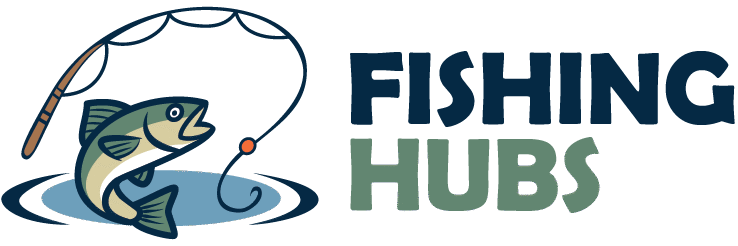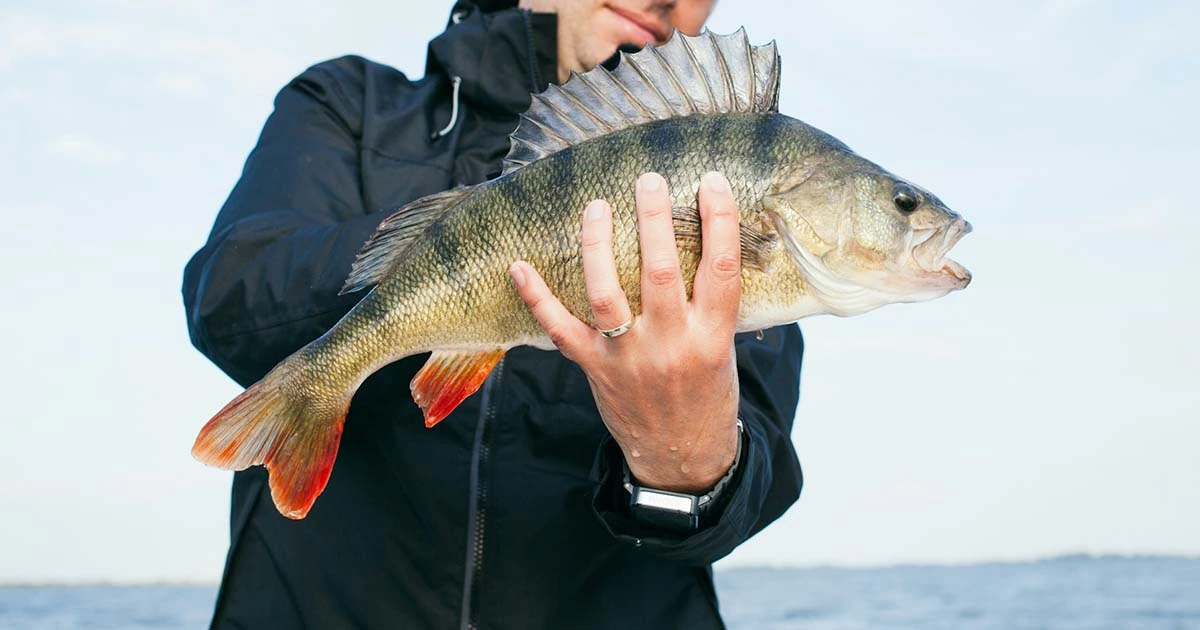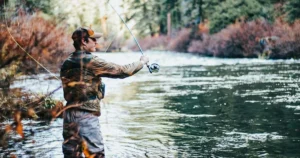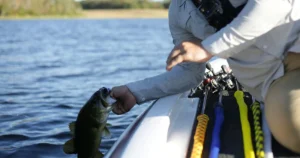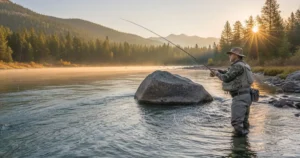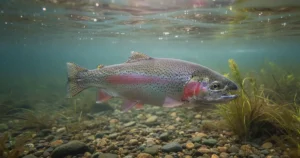Top Striped Bass Baits: What Works Best and Why
Table of Contents
Striped bass are one of the most sought-after game fish in North America, renowned for their power, fighting spirit, and delicious meat. Whether you’re casting from shore, drifting in a boat, or trolling in open water, understanding the best striped bass bait is crucial for consistent success. This comprehensive guide will equip you with the knowledge you need to select the perfect bait for any situation, increasing your chances of a memorable catch.
Understanding Striped Bass and Their Feeding Habits
Before diving into specific baits, it’s essential to grasp what makes striped bass tick. These opportunistic predators have a diverse diet, consuming a wide range of forage depending on their location, the time of year, and the available prey.
What Do Striped Bass Eat?
Stripers are not picky eaters. Their diet can include:
- Baitfish: Menhaden (bunker), herring, shad, eels, silversides, mackerel, and anchovies are primary food sources.
- Crustaceans: Crabs (green crabs, lady crabs, blue crabs), shrimp, and even lobsters can be on the menu, especially in rocky areas.
- Worms: Bloodworms and sandworms are particularly effective, especially in estuarine and inshore environments.
- Squid: A common prey item, especially in coastal waters.
Key Factors Influencing Feeding
Several factors influence where and when striped bass feed, and consequently, what bait they’ll be most interested in:
- Water Temperature: Stripers prefer water temperatures between 50 and 70 degrees Fahrenheit. They will often seek cooler, deeper water in the summer and shallower, warmer water in spring and fall.
- Tides and Current: Moving water concentrates baitfish, making it easier for stripers to ambush their prey. Focus your efforts around areas with strong tidal flow, such as inlets, estuaries, and bridge pilings.
- Light Conditions: Dawn, dusk, and nighttime are prime feeding times for striped bass, as low light gives them an advantage over their prey.
- Bait Presence: The most important factor! Find the bait, and you’ll find the bass. Look for diving birds, surface commotion, or use your fish finder to locate schools of baitfish.
Live Baits: The Irresistible Choice
When it comes to how to catch bass, especially larger ones, live bait often reigns supreme. The natural movement and scent of live bait are incredibly enticing to striped bass.
Menhaden (Bunker)
Menhaden, often called bunker or pogies, are a top-tier striped bass bait due to their oily nature and abundance.
- Why they work: Their high oil content creates a strong scent trail in the water, attracting stripers from a distance. Their size also appeals to larger bass.
- How to rig them:
- Live-lining: Hook a live menhaden through the nose, back, or tail with a circle hook (often required by law for bait fishing for stripers). Let it swim freely or drift it with the current.
- Chunking: Cut menhaden into chunks and fish them on the bottom or drift them. This creates a powerful scent slick.
Eels
American eels are another highly effective live bait, particularly for trophy-sized striped bass.
- Why they work: Their snake-like movement is irresistible to large stripers, mimicking a natural and high-calorie meal.
- How to rig them: Hook an eel through the lips or just behind the dorsal fin. Use a stout leader and a sharp circle hook. Eels are best fished at night or in low-light conditions.
Herring and Shad
Alewives and blueback herring are excellent striped bass bait, especially during their migratory runs. Shad also make for fantastic bait.
- Why they work: These baitfish are a staple in the striper diet.
- How to rig them: Similar to menhaden, they can be live-lined or fished as cut bait.
Worms (Bloodworms and Sandworms)
For shore fishing and targeting smaller to medium-sized stripers, bloodworms and sandworms are incredibly effective, especially in estuaries and shallow flats.
- Why they work: Their strong scent and natural movement appeal to stripers rooting around the bottom.
- How to rig them: Thread them onto a small to medium-sized circle hook, ensuring the hook point is exposed. A fish-finder rig or a simple bottom rig with a sinker works well.
Artificial Lures: Versatility and Action
While live bait is often king, artificial lures offer incredible versatility, allowing you to cover more water and mimic a wider range of prey. For effective bass fishing how to use lures is a skill that develops with practice.
Soft Plastics
Soft plastics are incredibly versatile and can imitate a variety of baitfish, eels, or worms.
- Why they work: Their lifelike action and soft feel encourage stripers to hold on longer, giving you time to set the hook.
- Popular options:
- Paddle-tail swimbaits: Mimic baitfish and work well with a steady retrieve.
- Soft plastic jerkbaits (e.g., Slug-Go): Can be twitched and paused to imitate a wounded baitfish.
- Eel imitations: Great for targeting larger fish, especially at night.
- How to use them: Rig on a jig head appropriate for the depth and current. Experiment with retrieve speeds and pauses.
Key Takeaway:
Soft plastics offer a realistic presentation and can be highly effective when stripers are focused on smaller baitfish.
Plugs and Hard Baits
These lures are designed to mimic larger baitfish and can be highly effective for provoking aggressive strikes.
- Why they work: Their erratic actions, vibrations, and sometimes rattling sounds can trigger a predatory response.
- Popular options:
- Swimming plugs (e.g., SP Minnow, Bomber A-Salt): Excellent for casting from shore or trolling, they dive and wobble, imitating a swimming baitfish.
- Poppers: Create commotion on the surface, drawing strikes from aggressive stripers, especially during low-light conditions. Ideal for targeting fish feeding on the surface.
- Pencil poppers: Require a “walk-the-dog” retrieve, creating an enticing side-to-side action.
- Diving plugs: Can reach deeper depths, useful when fish are holding lower in the water column.
- How to use them: Vary your retrieve speed and incorporate pauses or twitches to make the lure more erratic.
Jigs
Jigs are a staple in any striper angler’s tackle box, offering a wide range of applications.
- Why they work: Their weighted design allows them to be fished at various depths, and they can be jigged to imitate a struggling baitfish or a bottom-dwelling creature.
- Popular options:
- Bucktail jigs: Classic and highly effective, especially when tipped with a soft plastic trailer or pork rind. They can imitate squid or baitfish.
- Diamond jigs: Heavy and flashy, ideal for vertical jigging in deeper water or when fish are schooled up.
- Soft plastic jigs (e.g., lead heads with soft plastic tails): Versatile for mimicking various baitfish.
- How to use them: Cast and retrieve with a bouncing motion, or vertically jig them near structure or suspended schools of fish.
Specific Fishing Scenarios and Bait Choices
The best striped bass bait can change dramatically depending on where and how you’re fishing.
Shore Fishing
For shore fishing, accessibility and casting distance are key.
- Live Baits:
- Bloodworms and sandworms are excellent for bottom fishing in shallower areas.
- Cut bait (menhaden, mackerel, squid) fished on a fish-finder rig is highly effective, especially in areas with current.
- Artificial Lures:
- Swimming plugs and soft plastics (paddle-tail swimbaits, jerkbaits) are great for covering water.
- Poppers can be exciting during dawn or dusk, or when stripers are breaking on the surface.
- Bucktail jigs are a must-have for probing deeper troughs and rips.
“When I’m surf fishing, I always have a few different options: a heavy casting plug for distance, a soft plastic for a more subtle approach, and some cut bait ready if I find a good hole.” – A seasoned surf angler
Boat Fishing (Trolling, Drifting, Casting)
Boat fishing offers more versatility in terms of reaching different depths and areas.
- Trolling:
- Umbrella rigs and Mojo rigs: These large rigs simulate a school of baitfish and are incredibly effective for covering large areas, especially on bass fishing on a lake or large open waters.
- Large swimming plugs: Can be trolled at various depths.
- Drifting:
- Live bait: Menhaden, eels, or herring drifted with the current near structure or bait schools.
- Cut bait: Effective when drifting over deeper areas or when chumming.
- Jigs: Vertical jigging with diamond jigs or heavy bucktails when you mark fish on your electronics.
- Casting:
- All artificial lures discussed (soft plastics, plugs, jigs) can be cast effectively from a boat to target visible schools of fish or structure.
Bass Fishing on a Lake (Freshwater Stripers)
While often associated with saltwater, many lakes across the U.S. are stocked with landlocked striped bass. Bass fishing on a lake for stripers often involves different bait considerations.
- Live Baits:
- Threadfin shad, gizzard shad, or blueback herring: These are often the primary forage in freshwater lakes, making them top live bait choices.
- Shiners: Can also be effective.
- Artificial Lures:
- Spoons (casting or jigging): Mimic wounded baitfish and are very effective, especially for suspended fish.
- Swimbaits: Larger paddle-tail swimbaits that imitate shad or herring.
- Topwater lures: Pencil poppers or walking baits can be exhilarating when stripers are busting bait on the surface.
- Soft plastic jerkbaits: Fished on a jig head, these can be deadly when fish are finicky.
Essential Fishing Tips for Bass Fishing
Beyond just the bait, a few key fishing tips for bass fishing will elevate your game.
- Match the Hatch: Always try to use bait or lures that mimic the size and type of forage currently available to the stripers in your fishing area. Ask local bait shops what the bass are feeding on.
- Observe Your Surroundings: Look for signs of feeding activity: diving birds, splashes on the surface, or baitfish jumping out of the water. These are indicators that stripers are actively feeding.
- Understand the Tides and Current: For saltwater bass fishing how to read the tides is paramount. Fish often feed most actively during strong tidal movements, especially around structure that creates current breaks.
- Vary Your Retrieve: Don’t just reel in at a constant speed. Experiment with fast retrieves, slow retrieves, pauses, and erratic twitches to see what triggers a strike.
- Use the Right Gear: Ensure your rod, reel, and line are matched to the size of the fish you’re targeting and the type of bait/lure you’re using. Heavy braided line with a fluorocarbon leader is a common and effective setup.
- Stay Mobile: If you’re not getting bites, don’t be afraid to move to a new spot. Stripers are often on the move, following bait.
Conclusion
Catching striped bass is an incredibly rewarding experience, and having the right striped bass bait is a significant part of the equation. Whether you opt for the natural allure of live bait like menhaden and eels, or the versatility and action of artificial lures such as soft plastics, plugs, and jigs, understanding their effectiveness in different scenarios is key. By combining your bait selection with a solid grasp of striper feeding habits and essential fishing tips for bass fishing, you’ll be well on your way to consistent success. Remember to always consider the specific conditions—from shore fishing to bass fishing on a lake—and adapt your approach accordingly. Good luck, and tight lines!
Key Takeaways
- Live baits like menhaden, eels, herring, and worms are incredibly effective due to their natural scent and movement.
- Artificial lures such as soft plastics, plugs, and jigs offer versatility and allow you to cover more water.
- Match the hatch by using baits or lures that mimic the local forage.
- Understand environmental factors like water temperature, tides, and light conditions.
- Vary your retrieve and stay mobile to find actively feeding fish.
FAQ
Q1: What is the best all-around striped bass bait?
A1: While there’s no single “best” bait for every situation, menhaden (bunker) are widely considered one of the most effective due to their oily nature and appeal to both small and large stripers, whether fished live or as cut bait. Eels are also incredibly potent for larger fish.
Q2: Can I use freshwater baits for striped bass in saltwater?
A2: It depends on the specific bait. While stripers are adaptable, they typically prefer the forage native to their environment. For example, a freshwater worm might work, but marine bloodworms or sandworms are usually more effective. It’s best to use baits that mimic what the stripers are naturally feeding on in that specific body of water.
Q3: What’s the best bait for shore fishing for striped bass at night?
A3: At night, eels are incredibly effective for large stripers. Additionally, dark-colored swimming plugs or soft plastic eel imitations can be very productive. Cut bait, like fresh menhaden or mackerel, fished on the bottom also works well due to its strong scent.
Q4: How important is using a circle hook with bait for striped bass?
A4: Extremely important! In many areas of the United States, non-offset circle hooks are legally required when fishing for striped bass with bait. This is to reduce gut hooking, which significantly increases the survival rate of released fish. Always check your local regulations.
Q5: Are striped bass found in lakes, and if so, what bait works there?
A5: Yes, landlocked striped bass are found in many large freshwater lakes across the U.S. For bass fishing on a lake, live bait like threadfin shad, gizzard shad, or blueback herring are excellent. Artificial lures such as spoons, swimbaits, and topwater lures that imitate these baitfish are also highly effective.
